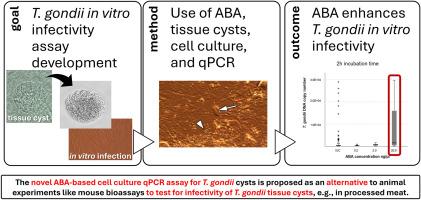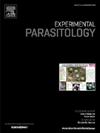用脱落酸研究刚地弓形虫感染性的体外测定方法的建立。
IF 1.6
4区 医学
Q3 PARASITOLOGY
引用次数: 0
摘要
常见的弓形虫寄生虫可以感染所有温血动物,包括人类。虽然大多数人类感染仍无症状,但临床弓形虫病可发展成致命疾病。感染通常是通过口服摄入猫粪便中的组织囊肿或卵囊而感染的。目前,小鼠生物试验是评价肉品感染性的最后实验。本研究旨在建立一种基于细胞培养和定量聚合酶链反应(qPCR)的组织囊肿体外感染性检测方法。植物激素脱落酸(ABA)被用于增加寄生虫的繁殖。用小鼠组织中的慢殖子感染人包皮成纤维细胞(HFF)宿主细胞。治疗组包括未感染对照组、感染未治疗组和感染ABA治疗组。添加的ABA浓度为0.2 ~ 20 ng/μl,去除ABA的时间为2 ~ 18 h。感染后48 h,用qPCR法测定培养细胞中弓形虫脱氧核糖核酸(DNA)的含量。结果表明,用浓度为2 ng/μl的ABA孵育4 ~ 6 h或用浓度为20 ng/μl的ABA孵育2 h,疟原虫DNA拷贝数显著增加。结果表明,该体外检测方法适用于弓形虫囊感染性的检测。本文章由计算机程序翻译,如有差异,请以英文原文为准。

Development of an in vitro assay using abscisic acid to study Toxoplasma gondii infectivity
The common parasite Toxoplasma gondii can infect all warm-blooded animals, including humans. Although most infections in humans remain asymptomatic, clinical toxoplasmosis can develop into a fatal disease. Infections are usually contracted by oral ingestion of tissue cysts or oocysts contained in cat feces.
Currently, the mouse bioassay is applied as a final experiment to evaluate meat infectivity. This study aims to establish an alternative cell culture and quantitative polymerase chain reaction (qPCR)-based in vitro infectivity assay for tissue cysts. The phytohormone abscisic acid (ABA) is applied to increase parasite multiplication.
A human foreskin fibroblast (HFF) host cell culture was infected with bradyzoites from mouse tissue. Treatment groups included uninfected controls, infected untreated controls, and infected ABA treated groups. The applied ABA concentrations used ranged from 0.2 ng/μl to 20 ng/μl, and ABA incubation times ranged from 2 h to 18 h before ABA removal. At 48 h after infection, T. gondii deoxyribonucleic acid (DNA) in the cell cultures was quantified by qPCR. The results indicate that parasite DNA copy numbers are markedly increased when using ABA at 2 ng/μl for 4–6 h or at 20 ng/μl for 2 h incubation. Our results indicate that this newly established in vitro assay is suitable to determine T. gondii cyst infectivity.
求助全文
通过发布文献求助,成功后即可免费获取论文全文。
去求助
来源期刊

Experimental parasitology
医学-寄生虫学
CiteScore
3.10
自引率
4.80%
发文量
160
审稿时长
3 months
期刊介绍:
Experimental Parasitology emphasizes modern approaches to parasitology, including molecular biology and immunology. The journal features original research papers on the physiological, metabolic, immunologic, biochemical, nutritional, and chemotherapeutic aspects of parasites and host-parasite relationships.
 求助内容:
求助内容: 应助结果提醒方式:
应助结果提醒方式:


